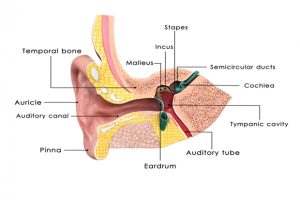
Senior author Daniel M. Merfeld explained, “In our study, vestibular decline was clearly evident above the age of 40. Increased thresholds correlate strongly with poorer balance test results, and we know from previous studies that those who have poorer balance have much higher odds of falling.”
Over half of the population will visit a doctor about a symptom related to the vestibular system. The vestibular system is made up of tiny canals in the ears which are responsible for receiving information regarding motion, balance, and spatial orientation.
The researchers performed balance and motion tests on 105 healthy people aged 10 to 80, and measured their vestibular threshold. No significant differences were found between the vestibular threshold of men and women. However, vestibular threshold was found to be higher among participants over the age of 40.
A higher vestibular threshold was associated with greater failure in balance tests. Using previous data, the researchers suggested that vestibular system dysfunctions could contribute to nearly 152,000 American deaths annually.
Dr. Merfeld concluded, “We’ve known for a long while that patients with vestibular disorders have disturbed balance. If worse vestibular function leads to falls, perhaps we can develop balance aids or physical therapy exercises to improve balance or vestibular function and prevent those falls.”
Vestibular system and maintaining balance
The vestibular system is a series of fluid-filled tubes and chambers that run inside the inner ear. Nerve endings detect movement, direction, and gravity of the head and neck. The brain’s ability to control balance and movement depends on the signals sent from the nerves of the vestibular system.
After the age of 55, the nerve cell count in the vestibular system – align with blood flow to the inner ear – begins to decrease. Dizziness and imbalance are a common consequence of age-related changes to the vestibular system.
Age-related changes to the vestibular system can also result in hearing loss due to the decrease in the blood flow required to activate the parts of the ear involved in sound processing.
Imbalance as a result of aging can be attributed to many factors such as impaired inner ear function, cardiovascular health, neurological disease, arthritis, mental status, nutrition, impaired vision, along with lifestyle and environmental factors.
Here are some exercises you can perform in order to improve balance and prevent dizziness and injury:
Romberg exercise
- Stand in front of a wall and place a chair in front of you for support in case you feel you are about to fall.
- Place feet together and arms by each side.
- Stand up straight for at least 30 seconds, then rest for 30 seconds.
To progress, work your way up to a longer time and when you feel comfortable try this exercise with your eyes closed
Standing sway exercise – forward to back
- Stand in front of a wall and place a chair in front of you for support in case you feel you are about to fall.
- Stand with feet shoulder-width apart and arms by each side.
- Gently lean forward and back, shifting your weight from the front of your toes to your heel – do not bend at your hips.
- Increase leaning range without lifting your feet.
Standing sway – right to left
- Follow the positioning from the standing sway forward-to-back exercise.
- Instead of moving forward to back, shift your weight from left to right.
In addition to these exercises, guided activities like yoga and tai chi can also help you improve your balance. Practicing balance exercises is also a good way to maintain your health. Not only will you prevent falls, but you can become more active, which can offer numerous health benefits, too.